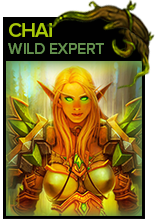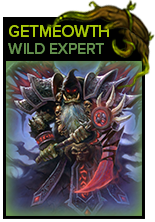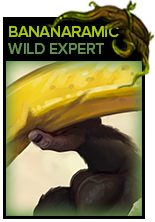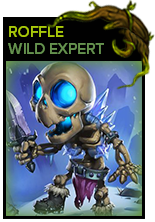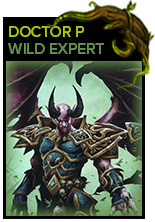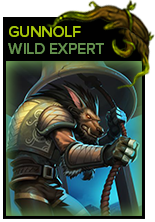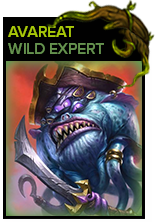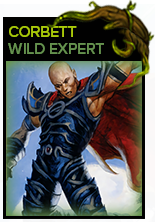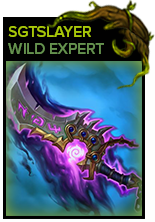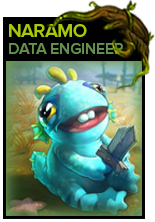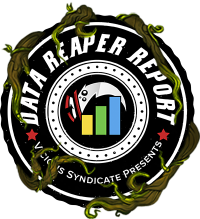
Welcome back to the Wild vS Data Reaper Report! We’re the experts from r/WildHearthstone, and we have partnered with Vicious Syndicate to create the Wild Data Reaper Report. We will be contributing the write-ups and analysis for the report, backed up by the statistics that Vicious Syndicate has become famous for. The data presented in this article is based on 40,000 games.
Our report this month comes after a few major events that have taken place in the Hearthstone Community. We have received a second set of nerfs for this expansion cycle, with Flametongue Totem, Cold Blood, and Equality getting hit to tone down the power of the Basic Set as well as Genn/Baku decks. Hunter’s Mark and Emerald Spellstone were hit to bring down the power of Hunter in Standard. We have also seen an influx of Standard players, coming over to compete in this year’s Wild Open.
In order to ensure that we can provide updated reports as quickly as possible, especially moving into a new expansion and rotation cycle, we encourage you to register to contribute your data to the Vicious Syndicate project in order to compile more comprehensive reports! Signing up is quick and easy and your contributions are extremely important and much appreciated!
Quick Links
Class/Archetype Distribution | Matchup Winrates | vS Power Rankings | Meta Score | Class Analysis & Decklists | How to Contribute | Credits
Class/Archetype Distribution
[TABS_PRO id=19018]
Nerfs to two of the three most popular decks in the format have shaken things up quite substantially. After dominating play rates for a long time, Even Shaman is no longer the most popular deck in Wild. Odd Rogue’s popularity has shrunk even more drastically, and it’s now just a blip in the radar.
Priest is the most popular class in the format up until rank 5, spearheaded by Big Priest making up around 10% of the meta at lower rank brackets. Comprising the rest of the class is Reno Priest, the Standard-favorite Wall Priest, and some Inner Fire and Mind Blast dragon variants. At higher levels of play, Priest declines and settles as 4th in popularity.
Warlock has seen an increase in play and is the most popular class at the 4-L bracket. Reno Warlock remains the most popular archetype, followed by Cube Warlock, Even Warlock, and the newly, refined Mecha’Thun Warlock.
With Odd Rogue eating a nerf to Cold Blood, Aggro Kingsbane Rogue has taken its place. It is the most popular deck at higher levels of play, exceeding 10% of the field and keeping Rogue dominant in the format.
Mage has seen a significant increase in play, thanks to the power of Aluneth Mage against Big Priest, Rogues, and Warlocks. Aluneth Mage has essentially doubled its play rate. The play rates of Reno, Exodia, and Odd Mage have all seen a slight uptick in play as well.
Paladin has gone from one of the least played classes to one of the most popular classes at the 4-L bracket. It turns out that when Even Shaman and Odd Rogue fall, players flock to Paladin to find premiere board-based aggressive decks. Odd Paladin, Aggro Paladin, and Anyfin Paladin can all be found in noticeable numbers.
With Emerald Spellstone weakened, Hunter has focused its attention on Mech Hunter and Midrange Hunter, leaving Spell Hunter behind. Jade Druid is the most popular deck for a class that continues to languish at the bottom. Warrior’s representation is also modest, comprised mostly of Odd Warrior and Pirate Warrior.
[TABS_PRO id=19019]

[TABS_PRO id=19020]
While the balance changes were somewhat aimed to tone down the power level of Genn and Baku, Odd and Even decks are still very strong in Wild. Only Odd Rogue has been knocked down to Tier 2, while Odd Paladin, Even Warlock and Even Shaman remain in Tier 1. What might be encouraging is that we’re seeing a more diverse Tier 1, with other decks challenging the domination of Genn and Baku.
Tier 1 stalwart, Odd Paladin, is at the top of the Power Rankings. This is somewhat unsurprising, considering most trends that have occurred after the balance changes were very favorable to the archetype. Even Shaman has declined in play, and so did the Warrior class. Odd Paladin’s only other unfavorables are Warlock Decks. At the same time, it annihilates the most popular deck in the format at higher levels of play, Kingsbane Rogue. However, Paladin is not just about Baku. Odd Paladin is followed by Anyfin and Aggro Paladin to complete a top 3 trifecta, mirroring Paladin’s success in standard format.
Aluneth Mage finds itself solidly in Tier 1, thanks to great matchups against Priests, Shamans, Rogues, and Warlocks. With Paladin established as the archetype’s hardest counter, and the armor gain classes of Warrior and Druid not being particularly popular, the field has become extremely favorable for Aluneth Mage.
Even Shaman’s play rate may have dipped as a result of the nerf to Flametongue Totem, but the power level of the deck has persisted. Kingsbane Rogue is one of the premiere anti-control decks but has major issues dealing with aggressive decks, especially Paladins. Even Warlock maintains a strong spread against board-focused decks relying on early game initiative while being weaker to burn strategies and removal-heavy control decks.
A newcomer to Tier 1 is Mecha’Thun Warlock. The refinement of this archetype was accelerated thanks to the influx of Standard players flocking to this deck. Thanks to the power of Warlock’s removal kit and the Voidcaller package, Mecha’thun Warlock performs admirably against the main aggressive decks in the format. It struggles against Kingsbane Rogue and Even Warlock.
Tier 2 is where we find three hyper-aggressive decks: Pirate Warrior, Odd Rogue, and Mech Hunter. Cube Warlock and Big Priest round out Tier 2 as powerful counters to control decks, but both decks are crippled by the matchup against Kingsbane Rogue, keeping them out of the elite company.
In Tier 3, we find Jade Druid, the competitive bastion of the Druid class. Newly-emerging Midrange Hunter isn’t replicating its success in standard, for now, but it’s still young and unrefined compared to other Wild staples. Reno Priest has struggled in the post-patch meta due to the decrease in Even Shamans and the rise of hostile counters. Odd Warrior has declined in its stock and will likely continue to struggle if Mecha’thun Warlock rises further in play. The unrefined Odd Mage is also listed in Tier 3.
In Tier 4, Reno Warlock looks like the most overrated deck in the format, completely outclassed by the more consistent Warlock decks available. The current meta is hostile for Reno decks, and Reno Mage proves to be another casualty. We also find the situational “counterqueue” decks of Mill Rogue and Exodia Mage, and the ever-persistent Shudderwock Shaman in the bottom tier.
vS Meta Score
[TABS_PRO id=19021]
Class Analysis & Decklists
Druid | Hunter | Mage | Paladin | Priest | Rogue | Shaman | Warlock | Warrior
Unfortunately for fans of Malfurion, the last wave of Druid nerfs has still left him as the least played class at all levels of play, along with Warrior. A class historically built around ramping into a strong, sustainable late game is yet to recover from the nerfs to Wild Growth and Nourish. Druid finds itself as a class struggling for identity; with no archetypes that excel their rivals.
Jade Druid has been a mainstay of the Wild meta for a long time, and it currently sits in Tier 3. Traditionally, Jade Idol has been the ultimate late-game win condition, ensuring that without a Geist, your opponents would never win in Fatigue. But with the rise of Mecha’Thun Warlock to Tier 1, a counter mechanic is in place. In addition, while previously you could quickly ramp into Spreading Plague to counter aggressive decks such as Odd Rogues and Paladins, this line of play has become too slow for the format and Jade Druid struggles to keep up with aggressive decks before it’s able to stabilize. We will mention, however, that Starfall makes a huge difference in the Odd Paladin matchup and running two copies of it swings things in the Druid’s favor. It might be worth considering if the Paladin population explodes.
One adjustment from Jade Druid players is running Naturalize to disrupt their opponent by inflicting fatigue damage or causing overdraw as a backup win condition. A common scenario in which Naturalize is quite relevant is Kingbane Rogue after it casts Myra’s Unstable Element. Spiral took his list to the 2019 Wild Open and Spirituus hit #1 Legend on the EU server in March.
A new Druid deck that has started to emerge is Miracle Druid. It is built around utilizing Gadgetzan Auctioneer to quickly cycle through your deck through cheap spells, before swapping your empty deck with King Togwaggle to beat your enemy in fatigue. Based on limited data, Miracle Druid sits at Tier 4, but if the meta slows, it could get stronger.
Although Hunter lost its strongest Wild deck, Secret Hunter, it has managed to recover from the balance changes thanks to the rise of Mech Hunter as well as the emergence of Midrange Hunter, keeping the class in a relevant spot. While it’s clearly not one of the strongest classes, it can perform well enough to be competitive.
Mech Hunter is a hyper-aggressive deck that often looks to kill opponents by turn 4 or 5. However, Mech Hunter has no meaningful comeback mechanisms, so once it loses the board, it likely loses the game. This makes matchups against board-centric decks such as Paladin and Shaman very difficult. Mech Hunter performs well against passive decks that are slow to get on board and challenge its development, allowing it to connect Metaltooth Leapers.
While Midrange Hunter has been a very popular archetype in Standard, its development in Wild is still in its diapers. In anticipation of the Wild Open, Standard players attempted to transition the deck to Wild. Jakaso27’s list is the most popular one, piloted by several players to high legend ranks.
The nerf to Emerald Spellstone has brought down the popularity of Spell Hunter and Secret Hunter. Since these decks have become significantly less played, we have fewer data about their power level. Hunter aficionado Duwin has been experimenting with relative amounts of success with some lists, which we have provided here.
- Awedragon’s Mech Hunter
- Jakaso27’s Midrange Hunter
- Duwin’s Secret Hunter
- Duwin’s No-Barnes Spell Hunter
- Knoepklapper’s Cube Hunter
Mage has been happy with the recent balance changes. Aluneth Mage has entered Tier 1 for the first time since losing Mana Wyrm and is one of the strongest Wild Mage decks we’ve seen in a very long time. The other archetypes of the class are significantly weaker in comparison, none of them displaying a positive win rate.
Aluneth Mage is a fantastic choice in the current meta. With the popularity of Kingsbane Rogue, Warlocks and Priests, Aluneth Mage was able to rise to prominence. The combination of burn, alongside a secret package that is highly disruptive for these archetypes, makes Aluneth Mage a force to be reckoned with. The deck is very weak against aggressive Paladin decks and Mech Hunters, but other faster matchups are much more manageable.
Reno Mage remains in Tier 4. Its best options are teching against a few of the popular archetypes, such as Kingsbane Rogue and Paladin, giving it decent odds against both. A few players found minor success with this approach. Bananaramic piloted his list to top 50 legend. The list showcases a very light curve with a solid amount of draw that can do well against the popular aggressive archetypes.
Exodia Mage got slightly better in this meta, as the deck generally does well against slower archetypes. However, it remains mostly a narrow counter against specific decks. It is very weak against aggressive decks and has a terrible time facing the popular Kingsbane Rogue and Aluneth Mage.
Odd Mage has slowly been seeing more play, but the archetype is still very experimental. Its main strength are its Warlock matchups, but until it fleshes out into a consistent build on ladder, it’s difficult to conclude how strong it can be.
With a decrease in Even Shaman’s popularity, Paladin rises from the middle of the pack in frequency to among the big 3 of Wild. The High Priest Thekal + Molten Giants package made waves initially, and this month it’s become clear: this powerful early swing turn tastes great with everything. It’s become an auto-include in any Paladin deck that can play it, providing a free win button to already strong shells. Anyfin Paladin has adopted it to help shore up its inconsistent early game, while Aggro Paladin has also embraced it.
Odd Paladin has the highest win rate in the game, benefiting from its dominating matchup against Kingsbane Rogue and from its overall consistency. Paladin decks tend to have similar matchup spreads, but Odd Paladin beats the other Paladin decks. Having lost nothing from the Equality nerf, this powerhouse is back on top.
Anyfin Paladin is the belle of the ball after being out of the spotlight for quite a while. With a weaker game against Big Priest and more game against Even Warlock than Odd Paladin, Anyfin Paladin leverages an enormous amount of value in a tight shell, landing it by the top of Tier 1. T4COTASTIC hit #1 Legend with his Thekal build of Anyfin Paladin, and many players have had success with it. We’re also featuring Chriswimlee’s Anyfin list, which plays Keeper of Uldaman over the more popular Blessing of Kings to tech harder against Even Shaman and Big Priest.
Aggro Paladin also finds itself in Tier 1, as the third-most powerful Paladin deck. While the vanilla build is proven to be extremely powerful, we’re also featuring a different spin from Corbett who hit #1 Legend with a Kangor’s Endless Army build, and a Secret Paladin build.
- Roffle’s Odd Paladin
- T4COTASTIC’s #1 Legend Anyfin Paladin
- Chriswimlee’s Anyfin Paladin
- Mazuru’s Vanilla Aggro Paladin
- Corbett’s #1 Legend Mech Aggro Paladin
- Chai’s Aggro Secret Paladin
- Siveure’s Exodia Control Paladin
Unsurprisingly, Big Priest remains the most popular Priest deck in Wild. In fact, after the recent wave of nerfs, the archetype has surpassed Even Shaman as the most popular deck in Wild . There is good news, however, for the many players who despise this deck: Big Priest’s bark is bigger than its bite. Sure, the deck remains a force in Wild, but Big Priest is still outside of Tier 1 across all ranks and barely manages to hang on to its Tier 2 status at higher ranks. This can be attributed, in part, to the increase in Kingsbane Rogue, Big Priest’s worst nightmare, along with a resurgence in Aluneth Mage. Still, Big Priest continues to boast favorable matchups against all Warlock archetypes which means it will likely stay relevant in Wild for the foreseeable future.
Reno Priest, despite ranking as the best of the three Reno archetypes, is struggling in the current Wild metagame. In the past, the deck fed on the Even Shamans saturating ladder across all ranks. Now, the deck is far less likely to find favorable matchups, placing it at the bottom of Tier 3. Like Big Priest, Reno Priest is a victim of the rising tide of Kingsbane Rogue and Aluneth Mage. Unlike Big Priest, however, Reno Priest does not have strong enough matchups against the popular Warlock decks to offset this. As it stands, Reno Priest is on the decline. Memnarch has managed to hit an early #5 Legend with the list featured in this report.
Dragon Mind Blast Priest was showing signs of strength in previous reports and continues to gain traction after the balance changes. Like most combo variants of Reno Priest, the deck can end games quickly but the draw consistency of running two copies of key cards appears to be providing the deck with stronger matchups against the field, placing it in Tier 2 based on the low sample estimate available. Several high-legend Wild players, including Corbett, have been touting the strength of this archetype for some time and it appears the data confirms their stance on this archetype.
Dragon Inner Fire Priest may be the biggest surprise of this entire report. Previously, the deck was floundering in a format swimming with board-centric aggressive decks. Now, however, the archetype seems to have found a place in the post-nerf meta. While the popularity of the deck remains low, low-sample estimates put the deck in Tier 1, far above where it was historically found. The fact that Obsidian Statues and Voidlords, typically a frustration for aggressive decks, can be an asset for lists running Twilight Acolyte and Potion of Madness, could be part of what has propelled Inner Fire Priest up the tiers. With a bit more time to set up its combo, Inner Fire Priest may be back as a strong, competitive deck in Wild.
- CONCERNEDMOM’S Big Priest
- Corbett’s Dragon Mind Blast Priest
- Memnarch’s Reno Priest
- Control’s Dragon Inner Fire Priest
Over the last few seasons, the Rogue class has experienced exponential growth both in terms of deck versatility, as well as competitive prowess. Furthermore, two of its most promising archetypes, Kingsbane and Odd Rogue, showed remarkable ability to adapt and remain relevant in the meta even after key cards were nerfed.
Kingsbane Rogue continues to thrive in the Wild meta. Enjoying its Tier 1 status, the archetype is stronger than its old iteration ever was, with a playstyle reminiscent of classic Oil Rogue. The deck is in fact so popular that is has caused a shift in the meta, popularizing its biggest counters in Odd and Aggro Paladin and pushing Big Priest out of the competitive elite.
In stark contrast, Odd Rogue has dipped both in terms of popularity and win rate after the recent Cold Blood Nerf. With the spell now gone from the pool of available cards, the archetype lost a significant amount of burst. Minions that formerly had terrifying potential to be combined with Cold Blood for repeated damage swings, such as Argent Squire and Argent Horserider, pose a significantly lower threat. The ability for an explosive start or burst finish with any one-drop or charge minion has been removed. However, despite the reduction in the amount of burst available to the deck, it’s still a Tier 2 deck and can be very successful on ladder.
In the previous wild report, it was teased that Mill Rogue was enjoying a resurgence in popularity. This is very much still the case, as the archetype continues to maintain a strong presence at all levels of ladder play. It even managed to beat out Odd Rogue in popularity. Unfortunately, no matter the rank, the deck experiences an abysmal winrate clearly cementing it as a tier 4 deck at best, in the present meta.
Similarly to last season, there are other additional Rogue decks lurking around. Big Rogue isn’t seeing much play. The small sample size that we have obtained suggests that the deck is not too competitive, landing it in the Tier 4 category. Further to Big Rogue, Thief Rogue and Jade Rogue are also being experimented with, though it’s very unlikely that they are any good.
- Getmeowth’s Kingsbane Rogue
- Reverb’s Odd Rogue
- Roffle’s Mill Rogue
- Corbett’s Big Rogue
- LivehighHS’s Thief Rogue
- Control’s Jade Rogue
Although the archetype has decreased in popularity following the balance changes, Even Shaman remains one of the best performing decks in the format. A few developments in the meta have allowed Even Shaman to remain firmly in Tier 1.
Kingsbane Rogue is now the most popular deck at higher levels of play. This has been one of the driving forces behind the increased prevalence of various aggressive Paladin archetypes. Both of these have been highly beneficial shifts for Even Shaman, which maintains a strong overall matchup spread against other aggressive strategies. Meanwhile, many of Even Shaman’s counters (such as Odd Warrior and Even Warlock) have either stagnated or slightly decreased in popularity. With the nerf to Flametongue Totem, the target on Thrall’s back has shrunk dramatically, so even though Even Shaman is clearly weaker in a vacuum, the field has become more favorable to compensate. The featured list was used by NORE to hit #1 legend.
Shudderwock Shaman, however, cannot boast the same success story. Less and less of the archetype is seen as one moves from lower ranks to higher ranks. There is a good reason for this; it’s performing quite poorly. Neither Jade nor OTK variants have been able to produce consistently positive results. Regardless of approach, the deck exhibits glaring weaknesses to ongoing board pressure and to most other late-game oriented strategies. Player671 used the listed deck to compete in the Wild Open Finals.
Malygos Shaman has seen very limited play, although it has demonstrated a small number of success stories, such as Corbett’s #1 legend spot. Malygos Shaman has strong matchups against most Warlocks and Priests, two classes with no armor gain and typically low-pressure game plans. In contrast, it struggles badly against the majority of Druid, Warrior, and Mage decks.
Despite nerfs within the class, interest in Aggro Shaman failed to spike and experimentation has been limited. The deck uses strong early game minions, before transitioning into a burn plan and cycling through the deck using Spirit of the Frog.
Warlock has seen a rise in popularity since the recent balance changes. Overall, the rise in the popularity of Paladin has helped all Warlock archetypes, while the rise of Kingsbane Rogue has given the class its biggest challenge. Warlock currently has three decks sitting between Tier 2 and Tier 1, while Reno Warlock has lost its past prominence.
Even Warlock is a powerful midrange archetype that has great utility in the meta. It is similar to Cube Warlock in one of its main weaknesses – aggressive decks carrying burn, found in Rogue and Mage. But even with those weaknesses, the deck is very flexible due to its tech slots that can assist even the worst matchups. Bananaramic’s list was piloted to high legend and played in the Wild Open, featuring several techs to deal with a variety of potential threats.
Cube Warlock has a slightly worse matchup spread than its fellow Warlock archetype, Even Warlock. It has less room to tech against the popular Kingsbane Rogue and suffers from a few extra poor matchups on top of that. Besides the popularity of Paladin archetypes, which it is slightly favored against, the deck has dropped a tier since the last report due to the increasing weakness of the control archetypes it preys on.
Reno Warlock is a big loser in the current meta. Once upon a time, it was a deck that dominated the Wild metagame, but it currently has a terrible matchup spread, losing to most of the popular archetypes. There is no real reason to play Reno Warlock over other Warlock decks since it doesn’t do anything that they can’t do better. It is also terrible in every mirror matchup.
Mecha’thun Warlock has taken the meta by storm, becoming the strongest Warlock archetype. It is extremely well-rounded, similarly to Even Warlock, but has a combo finish that makes it dominant against slower decks. The consistent Voidcaller package gives it early game shutdown ability against aggro, while its win condition can be oppressive in slower matchups. This versatility allows the Mecha’thun Warlock to perform very well against the current meta, establishing it in Tier 1.
- Bananaramic’s Evenlock
- GetMeowth’s Cubelock
- GetMeowth’s Renolock
- Mecha’thun Warlock
- Kremepuff’s Mecha’thun Warlock
Things are not going too well for Garrosh. At the time of this report Warrior is the class with the lowest representation on ladder in all ranks, and only surpassing Druid in the 4-L bracket.
However, not all hope is lost for Mr. Hellscream. Pirate Warrior is a legit option for laddering. The deck boasts a solid matchup against one of the most popular decks in the meta in Kingsbane Rogue. This coupled with decent matchups against Odd Paladin and slow decks such as Big Priest and Cube Warlock put the deck at Tier 2. If you don’t face the Even Shaman police, you should be able to pillage ladder.
On the other side of the spectrum, going from hyper aggro to hard fatigue, we find Odd Warrior. The deck sits at Tier 3 and is the only deck that beats all the current aggressive strategies on ladder. This would intuitively put Odd Warrior in a good spot. However, inevitable win conditions are around, and Odd Warriors will be dreading a rise in Mecha’thun Warlocks. Coupled with Big Priest and other late game Warlock decks, there are several oppressive matchups that tank down Odd Warrior’s overall win rate which you want to avoid.
Barely anyone seems to be playing Control Warrior. This deck sacrifices turn 1 Tank Up! for even cost cards such as Warpath, Dead Man’s Hand and Dirty Rat. This deck looks to chain DMH until it fatigues the opponent with its removal kit and Coldlight Oracles.
Our Data Reaper Project, including the Data Reaper Live has 4,100 active contributors. Without them, this project would not be possible, so we’d like to thank all of our contributors for their help.
Preparing our weekly article requires a significant amount of time and effort from many individuals. We would like to wholeheartedly thank our current Patreons, whose generous donations help us fund computing and server costs.
vS Gold is a new membership plan aimed to support our efforts towards improving our content and data analysis while receiving some bonuses and extra features.
Contributors
Here are all the people that participated in bringing you this edition of the [Wild] vS Data Reaper Report:
















